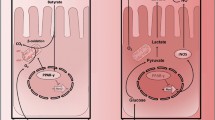Abstract
Background
Reactive oxygen species are involved in the pathogenesis of colorectal carcinoma. Clarification of oxidative/antioxidant specificities of different stages of colorectal carcinoma is of special importance.
Aim
To determine oxidative/antioxidant status in plasma of patients with different stages of colorectal carcinoma using malondialdehyde concentration, superoxide dismutase, catalase, glutathione peroxidase, and glutathione reductase activities and distribution of superoxide dismutase isoforms.
Methods
Lipid peroxidation and antioxidant enzymes activity were estimated using spectrophotometric methods. Reverse zymography was applied for characterization of superoxide dismutase isoforms.
Results
Lipid peroxidation is increased in all groups compared to the control, but without differences between different stages of colorectal carcinoma. Total superoxide dismutase activity is lower in all colorectal carcinoma groups than in control, and there is a significant increase in tumor stage IV when compared with tumor stage II. Manganese superoxide dismutase isoform is dominant in all groups and its relative activities are significantly higher than activities of a copper/zinc isoform. Total peroxidase potential reflected in catalase and glutathione peroxidase activity is increased when compared to the control, but without any significant differences between colorectal carcinoma groups. Glutathione reductase activity is lower in all colorectal carcinoma groups than in control, and a significant decrease in glutathione reductase activity was obtained between patients in tumor stage II and III compared to tumor stage IV.
Conclusions
Colorectal carcinoma is characterized by increased oxidative stress and antioxidant disbalance. Progression of disease is followed by an increase in redox disbalance.








Similar content being viewed by others
References
Kim JC, Kim DD, Lee YM, et al. Evaluation of novel histone deacetylase inhibitors as therapeutic agents for colorectal adenocarcinomas compared to established regimens with the histoculture drug response assay. Int J Colorectal Dis. 2009;24:209–218.
Maffei F, Angeloni C, Malaguti M, et al. Plasma antioxidant enzymes and clastogenic factors as possible biomarkers of colorectal cancer risk. Mutat Res. 2011;714:88–92.
Celis JE, Gromov P. Proteomics in translational cancer research: toward an integrated approach. Cancer Cell. 2003;3:9–15.
Bi X, Lin Q, Foo TW, et al. Proteomic analysis of colorectal cancer reveals alterations in metabolic pathways: mechanism of tumorigenesis. Mol Cell Proteomics. 2006;5:1119–1130.
Kim YJ, Kim EH, Hahm KB. Oxidative stress in inflammation-based gastrointestinal tract diseases: challenges and opportunities. J Gastroenterol Hepatol. 2012;27:1004–1010.
Kekec Y, Paydas S, Tuli A, Zorludemir S, Sakman G, Seydaoglu G. Antioxidant enzyme levels in cases with gastrointesinal cancer. Eur J Intern Med. 2009;20:403–406.
Halliwell B. Free radicals and antioxidants: updating a personal view. Nutr Rev. 2012;70:257–265.
Erel OA. A novel automated method to measure total antioxidant response against potent free radical reactions. Clin Biochem. 2004;37:112–119.
Ozgonul A, Aksoy N, Dilmec F, Uzunkoy A, Aksoy S. Measurement of total antioxidant response in colorectal cancer using a novel automated method. Turk J Med Sci. 2009;39:503–506.
Ohkawa H, Ohishi N, Yagi K. Assay for lipid peroxides in animal tissues by thiobarbituric acid reaction. Anal Biochem. 1979;95:351–358.
Sun M, Zigman S. Determination of superoxide dismutase in erythrocytes using the method of adrenaline autooxidation. Anal Biochem. 1978;90:81–89.
Flohe L, Otting F. Superoxide dismutase assays. Methods Enzymol. 1984;105:93–104.
Roland FB, Irwin WS. A spectrophotometric method for measuring the breakdown of hydrogen peroxide by catalase. J Biol Chem. 1952;195:133–140.
Wendel A. Glutathione peroxidase. Methods Enzymol. 1981;77:325–333.
Carlberg I, Mannervik B. Glutathione reductase. Methods Enzymol. 1985;113:484–490.
Papailiou J, Bramis KJ, Gazouli M. Theodoropoulos G Stem cells in colon cancer. A new era in cancer theory begins. Int J Colorectal Dis. 2011;26:1–11.
Valko M, Rhodes CJ, Moncol J, Izakovic M, Mazur M. Free radicals, metals and antioxidants in oxidative stress-induced cancer. Chem Biol Interact. 2006;160:1–40.
Skrzydlewska E, Sulkowski S, Koda M, Zalewski B, Kanczuga-Koda I, Sulkowska M. Lipid peroxidation and peroxidant and oxidant status in colorectal cancer. World J Gastroenterol. 2005;11:403–406.
Rainis T, Maor I, Lanir A, Shnizer S, Lavy A. Enhanced oxidative stress and leucocyte activation in neoplastic tissues of the colon. Dig Dis Sci. 2007;52:526–530.
Biasi F, Tessitore L, Zanetti D, et al. Associated changes of lipid peroxidation and transforming growth factor beta1 levels in human colon cancer during tumor progression. Gut. 2002;50:361–367.
Skrzydlewska E, Stankiewicz A, Sulkowska M, Sulkowski S, Kasacka I. Antioxidant status and lipid peroxidation in colorectal cancer. J Toxicol Environ Health A. 2001;64:213–222.
Skrzydlewska E, Kozuszko B, Sulkowska M, et al. Antioxidant potential in esophageal, stomach and colorectal cancers. Hepatogastroenterology. 2003;50:126–131.
Chang D, Wang F, Zhao YS, Pan HZ. Evaluation of oxidative stress in colorectal cancer patients. Biomed Environ Sci. 2008;21:286–289.
Zhu CH, Huang Y, Oberley LW, Domann FE. A family of AP-2 proteins down-regulate manganese superoxide dismutase expression. J Biol Chem. 2001;276:14407–14413.
Janssen AM, Bosman CB, van Duijn W, et al. Superoxide dismutases in gastric and esophageal cancer and the prognostic impact in gastric cancer. Clin Cancer Res. 2000;6:3183–3192.
Satomi A, Murakami S, Hashimoto T, Ishida K, Matsuki M, Sonoda M. Significance of superoxide dismutase (SOD) in human colorectal cancer tissue: correlation with malignant intensity. J Gastroenterol. 1995;30:177–182.
Janssen AM, Bosman CB, van Duijn W, et al. Superoxide dismutases in gastric and esophageal cancer and the prognostic impact in gastric cancer. Clin Cancer Res. 2000;6:3183–3192.
Skrzycki M, Majewska M, Podsiad M, Czeczot H. Expression and activity of superoxide dismutase isoenzymes in colorectal cancer. Acta Biochim Pol. 2009;56:663–670.
Ozdemirler Erata G, Kanbağli O, Durlanik O, et al. Induced oxidative stress and decreased expression of inducible heat shock protein 70 (ihsp 70) in patients with colorectal adenocarcinomas. Jpn J Clin Oncol. 2005;35:74–78.
Cvorovic J, Tramer F, Granzotto M, Candussio L, Decorti G, Passamonti S. Oxidative stress-based cytotoxicity of delphinidin and cyanidin in colon cancer cells. Arch Biochem Biophys. 2010;501:151–157.
Acknowledgment
This work was supported by grants of Ministry of Science and Technologic Development of the Republic of Serbia (Projects III_41033 and 175034).
Conflict of interest
None.
Author information
Authors and Affiliations
Corresponding author
Rights and permissions
About this article
Cite this article
Gopčević, K.R., Rovčanin, B.R., Tatić, S.B. et al. Activity of Superoxide Dismutase, Catalase, Glutathione Peroxidase, and Glutathione Reductase in Different Stages of Colorectal Carcinoma. Dig Dis Sci 58, 2646–2652 (2013). https://doi.org/10.1007/s10620-013-2681-2
Received:
Accepted:
Published:
Issue Date:
DOI: https://doi.org/10.1007/s10620-013-2681-2




